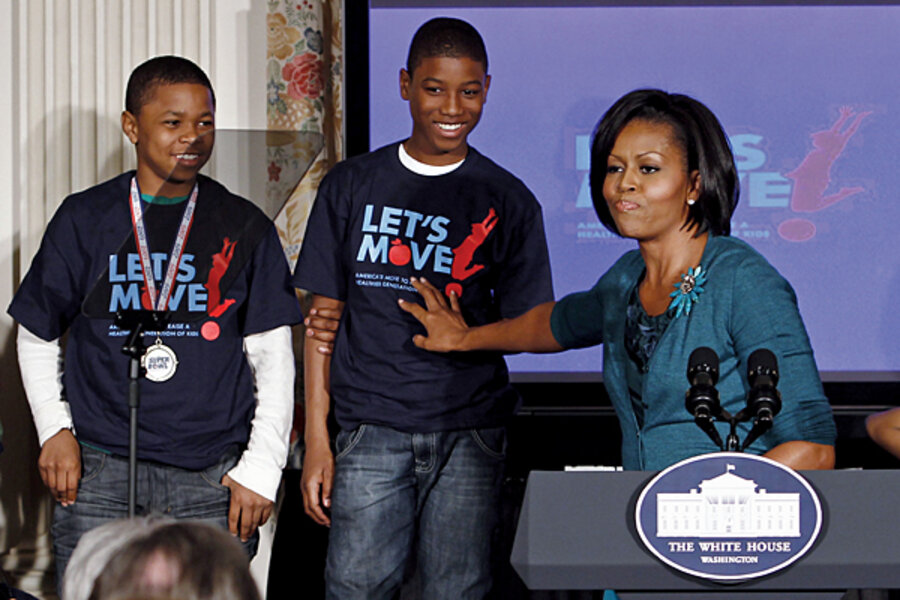'Let's Move': Michelle Obama takes on childhood obesity
| Washington
Michelle Obama may be the first lady of the United States, but at Brinkley Middle School in Jackson, Miss., last week, most people simply referred to her as “Michelle.”
Certainly that’s how Mrs. Obama wants it. She has a message to impart, and if people feel comfortable with her, maybe it will get through: America’s kids need to get active and lose weight to end childhood obesity.
One-third of American children are either overweight or obese, and with black and Hispanic children, the figure increases to one-half. Weight-related health issues are also on the rise, and Obama hopes that if children can develop a healthy lifestyle when they’re young, they can avoid these problems both now and as adults.
After a year as first lady, Obama has thrown herself into her signature “Let’s Move” antiobesity campaign, launched Feb. 9, with the verve of a candidate.
Wednesday Obama addresses the National Legislative Conference of the Parent Teacher Association. Her Let's Move campaign, which aims to end childhood obesity in one generation, will be the main topic.
She is reaching out to children, parents, governors, mayors, educators, school nutrition leaders, and food manufacturers. Her goal is ambitious: ending what she calls “the epidemic of childhood obesity” in a generation.
“Everyone has got to do their part,” she told the 1,000 people, almost all black, who came to hear her speak at Brinkley. “That’s why I’ve been traveling around the country, and I’m going to do this for years to come – asking everyone to step up and get involved.”
Tackling obesity isn’t as simple as telling folks to eat less and avoid the bad stuff. Some areas don’t have a full-service grocery store, leaving residents to shop at gas stations and convenience stores, where the only thing that’s crisp and green is the money in the cash register.
Obama calls these grocery-free zones “food deserts,” and they are found in both poor urban neighborhoods and sparsely populated rural areas. President Obama’s fiscal 2011 budget proposes $400 million in financing to help bring grocery stores to underserved areas and help small shops carry healthier items.
Urban food deserts tend to be in minority neighborhoods, and, unlike her husband, the first lady has not hesitated to tackle the racial dimension of policy head-on. When Obama launched her campaign, she acknowledged the challenge some city kids face in getting enough exercise.
“Urban sprawl and fears about safety often mean the only walking they do is out their door to a bus or a car,” she said.
Obama can also speak of her own life – and her role as a mother to two daughters – in a way that makes her relatable. As a child on the South Side of Chicago, she recalls running around outside after school, then coming home to a healthy home-cooked meal. Tall and lanky, Obama did not struggle with weight.
As a working mom – before Obama stepped into her current role, which comes with a household staff of about 100 people – she remembers well the challenge of coming home exhausted and having to make dinner for a family. Too often, fast food was the easy way out. When the girls’ pediatrician warned her about an uptick in their body mass index, that got her attention.
Now, she tells her audience in Jackson, “I’m thinking about all of you as a mother, not as a first lady.”
But Obama is the first lady, a role that gives her a unique platform for advocacy. And unlike her husband, who has to address the nation’s thorniest issues, she can pick her topics. In her first year, she focused on the needs of military families and on mentoring girls, and, in a hint of the healthy-eating campaign to come, planted a White House garden. By year’s end, she was a celebrity – and more popular than either Hillary Clinton or Laura Bush were after a year in the White House. But if Obama had stopped there, she risked being an underachiever.
“I would have been critical, probably, if she hadn’t settled on childhood obesity” as her main cause, says Myra Gutin, author of a book on first ladies. “You’ve got so much you can do with that White House podium.”
Obama does have her detractors. Rush Limbaugh accused her of calling her daughters “fat,” which she didn’t. During the campaign, she made some verbal stumbles, and conservative media promoted an image of her as angry and unpatriotic. But her time in the White House has been gaffe-free, a testament to her growth as a public figure.
With all her focus on weight, does she risk becoming a scold?
“Sure, but that’s part of what’s expected,” says Carl Sferrazza Anthony, historian of the National First Ladies’ Library in Canton, Ohio. Nancy Reagan told us not to do drugs. Barbara Bush told us to read books. Michelle Obama wants us to eat our vegetables.
Some pundits have criticized Obama for taking on only safe causes. After all, while her husband does battle amid fierce partisanship in Washington, she can stand aside a top Republican, Mississippi Gov. Haley Barbour, as she did in Jackson, and find complete accord on an issue.
Part of it may be that, as the first African-American first lady, Obama “does not want to rock the boat,” says Gil Troy, an expert on US first ladies at McGill University in Montreal. “This may be selling herself short – but it may also be a shrewd reading of the political terrain.”
In Jackson, Obama’s appearance was pure gold. Talecia Garrett Sa’Aadat felt so strongly about the message – and the messenger – that she brought her father and three daughters, ages 8 to 11, to hear Obama speak.
Ms. Sa’Aadat says she talks to her daughters often about nutrition and has replaced passive after-school programs with more active sports. But she appreciates the extra “backup” from the first lady.
Clifford Austin, a cafeteria worker at Brinkley, praises Obama’s down-to-earth approach, pointing out how she circulated among the children, stopping to talk and hug.
“She gets right in there with them,” Mr. Austin says.
He notes that Mississippi – which has the highest obesity rate in the country – is making small changes. Last year, Brinkley’s cafeteria staff began replacing fryers with ovens. Three times a week, cafeteria staff can work with a physical trainer during school hours. Such innovations, along with the state’s “Let’s Go Walkin’ Mississippi” initiative, and school walking trails, were part of what sparked Obama’s interest in the state.
“It’s a wonderful platform and much-needed,” said local minister Velita Streat, citing the recent movie “Precious,” which links childhood obesity, sexual abuse, and poor self-esteem with low education, teen pregnancy, and a lifetime of struggle. “It’s a starting point.”
Carmen Sisson contributed to this report from Jackson, Miss.






